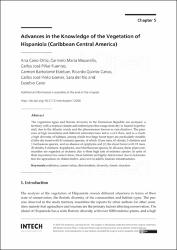/admin/item?itemID=4737496d-ebae-44a8-b25e-4ab14ba627b7
Advances in the knowledge of the vegetation of Hispaniola (Caribbean Central America)

View/
Type of Access
OpenMaterial Type
Book (chapter)Type of Content
Scientific researchSubject
Biodiversidad - República DominicanaFlora ─ República Dominicana
Hábitats y especies
Biogeografía
Language
EnglishCollection
- Investigación ambiental [1758]
Metadata
Show full item record| Abstract: | The vegetation types and floristic diversity in the Dominican Republic are analysed, a territory with a tropical climate and ombrotypes that range from dry to humid-hyperhumid, due to the Atlantic winds and the phenomenon known as rain shadows. The presence of high mountains and different substrates have led to a rich flora, and as a result, a high diversity of habitats, among which two large forest types are particularly notable: (1) the dry forest with 81 endemic species, of which 10 are trees, 65 shrubs, 5 climbers and 1 herbaceous species, and an absence of epiphytes and (2) the cloud forest with 19 trees, 20 shrubs, 8 climbers, 4 epiphytes, and 6 herbaceous species. In all cases, these plant communities are regarded as endemic due to their high rate of endemic species. In spite of their importance for conservation, these habitats are highly deteriorated due to deforestation for agriculture, to obtain timber, and even to add to tourism infrastructures. |
| Author(s): | Cano Ortiz, Ana
Musarella, Carmelo María Piñar Fuentes, Carlos José Bartolomé Esteban, Carmen Quinto Canas, Ricardo Pinto Gomes, Carlos José Río, Sara del Cano Carmona, Eusebio |
| Date: | 2018 |
| Published: | Sebata, A. (ed.), Vegetation. London, UK: IntechOpen (pp. 83-99) |
| Citation: | Cano Ortiz, A. et al. (2018). Advances in the knowledge of the vegetation of Hispaniola (Caribbean Central America). In Sebata, A. (ed.), Vegetation. London, UK: IntechOpen (pp. 83-99). Recuperado de: |
| URI: | https://bvearmb.do/handle/123456789/2997
|

